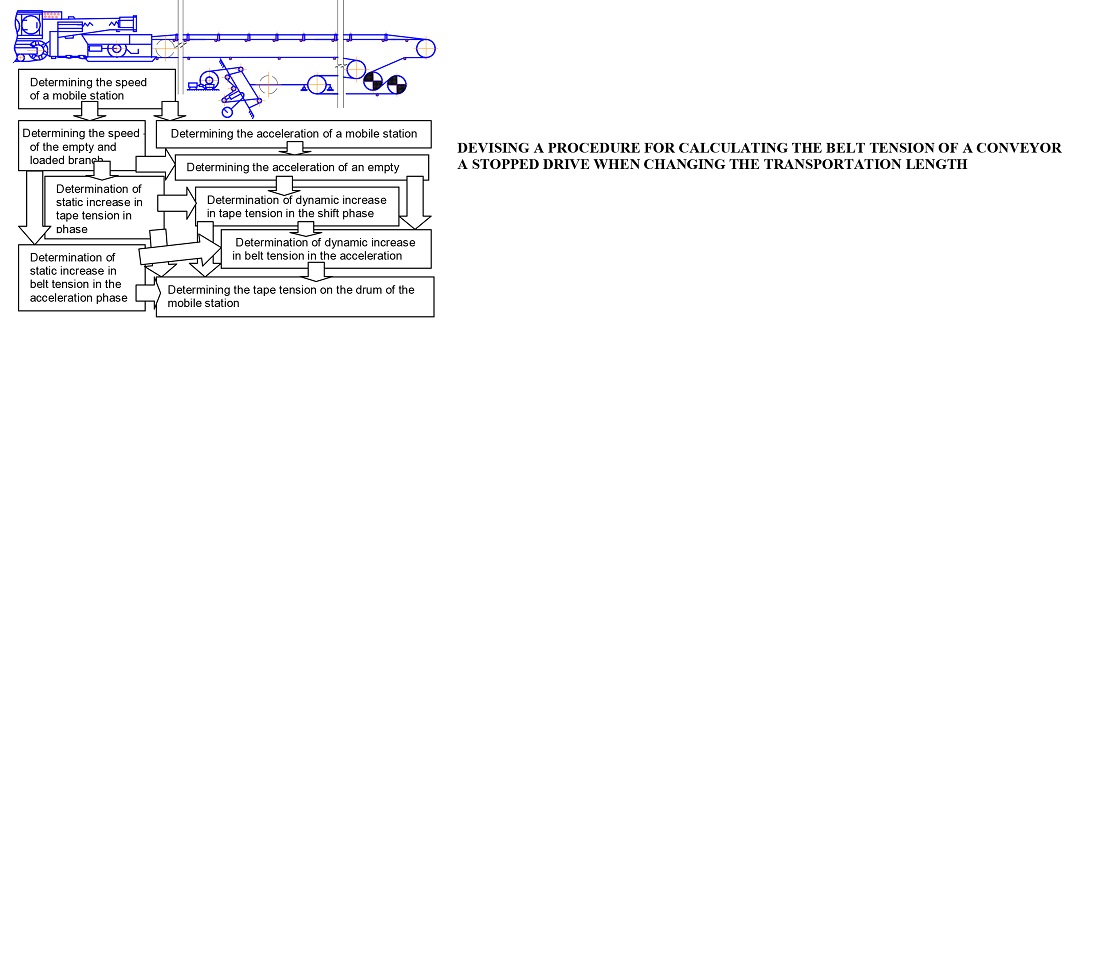Розробка процедури розрахунку натягнень стрічки конвеєра з зупиненим приводомпід час зміни довжини транспортування
DOI:
https://doi.org/10.15587/1729-4061.2025.322461Ключові слова:
стрічковий конвеєр, програмне забезпечення, експлуатація, натягнення стрічки, теоретичні дослідженняАнотація
Об’єктом дослідження був робочий процес стрічкового конвеєра. Досліджувалася проблема проектування стрічкових конвеєрів з урахуванням натяг стрічки під час зміни довжини транспортування.
Встановлено, що під час зміни довжини не працюючого конвеєра збільшується статичне і динамічне навантаження стрічки. Зміна статичного навантаження стрічки на барабані пересувної станції залежить від швидкості пересувної станції і параметрів конвеєра. Динамічна навантаженість стрічки залежить від прискорення стрічки, яке пов'язане з прискоренням пересувної станції під час зміни довжини транспортування конвеєра.
Зміна навантаженні стрічки на барабані пересувної станції відбувається в дві фази: перший фаза – зрушення, друга фаза – розгону и зміни довжини транспортування. Перша фаза діє декілька секунд і натяг стрічки дорівнює силі опору руху порожньої гілки конвеєра. Друга фаза діє поки довжина транспортування змінюється і натяг стрічки залежить від параметрів конвеєра і прискоренню пересувної станції в цей час.
Для не працюючого конвеєра, що змінює довжину конвеєра, статичне натягнення стрічки на барабані пересувної станції може збільшуватись в 2 рази від початкового. Динамічна навантаженість стрічки може мати значне збільшення якщо прискорення пересувної станції не розтягнуте у часі і має великі значення.
При експлуатації конвеєра змінювати довжину транспортування треба при працюючому конвеєрі.
З застосуванням програмного забезпечення Mathcad виконано апробацію для зупиненого конвеєра зі зміною довжиною транспортування. Розрахунки показали,що натяг стрічки на 10% більшеніж для конвеєра з працюючим приводом.
Отримані результати дають можливість правильно експлуатувати конкурентноздатні машини обладнані стрічковим конвеєром зі змінною довжиною транспортування
Посилання
- Allekotte, K., Schmidt, H. (2001). Entwicklung von längen veränderlichen Gurtförderern. Gluckauf, 12.
- Kiktev, N. (2015). Software for calculation of belt conveyors at their computer-aided design. Technology Audit and Production Reserves, 5 (2 (25)), 16. https://doi.org/10.15587/2312-8372.2015.51784
- Fimbinger, E. (2019). Methodology for the Simulation of Conveyor Belts Using the Discrete Element Method. Available at: https://www.nafems.org/publications/resource_center/nwc_19_327/
- Fimbinger, E. (2021). A Methodology for Dynamic Belt Simulation. Dipl. Leoben, 326. https://doi.org/10.34901/mul.pub.2021.3
- Wang, X., Mu, D. (2019). Dynamic model research and Intelligent system development of belt conveyor. IOP Conference Series: Materials Science and Engineering, 493, 012101. https://doi.org/10.1088/1757-899x/493/1/012101
- Karolewski, B, Ligocki, P. (2014). Modelling of long belt conveyors. Eksploatacja i Niezawodnosc – Maintenance and Reliability, 16 (2), 179–187. Available at: https://www.researchgate.net/publication/284152070_Modelling_of_long_belt_conveyors
- Gerdemeli, İ., Kurt, S., Dayan, E. T. (2014). Belt conveyor design and analysis. Scientific proceedings xi international congress "Machines, Technolоgies, Materials". Available at: https://mtmcongress.com/proceedngs/2014/1/13.BELT%20CONVEYOR%20DESIGN%20AND%20ANALYSIS.pdf
- Zeng, F., Yan, C., Wu, Q., Wang, T. (2020). Dynamic Behaviour of a Conveyor Belt Considering Non-Uniform Bulk Material Distribution for Speed Control. Applied Sciences, 10 (13), 4436. https://doi.org/10.3390/app10134436
- Wang, L., Li, H., Huang, J., Zeng, J., Tang, L., Wu, W., Luo, Y. (2023). Research on and Design of an Electric Drive Automatic Control System for Mine Belt Conveyors. Processes, 11 (6), 1762. https://doi.org/10.3390/pr11061762
- He, D., Pang, Y., Lodewijks, G. (2016). Speed control of belt conveyors during transient operation. Powder Technology, 301, 622–631. https://doi.org/10.1016/j.powtec.2016.07.004
- Gavryukov, A. V., Tret'yak, A. V. (2014). Matematicheskaya model' protsessa rasprostraneniya uprugih deformatsiy, v lente konveyera s izmenyayushcheysya dlinoy transportirovaniya. Naukovi pratsi Donetskoho natsionalnoho tekhnichnoho universytetu. Seriya «Hirnycho-elektromekhanichna», 1 (27), 41–77.
- Tret'yak, A. V. (2013). Eksperimental'nye issledovaniya dinamicheskoy nagruzhennosti lenty konveyera s izmenyayushcheysya dlinoy transportirovaniya v protsesse ego udlineniya. Naukovi pratsi DNTU, 1 (25), 191–200.
- Gavryukov, A. V. (2007). Teoriya i praktika ispol'zovaniya lentochnyh konveyerov, rabotayushchih pri izmenyayushcheysya dline. Makeevka: DonNASA, 119.
- Kuznecov, B. A. (1971). Dinamika puska dlinnyh lentochnyh konveyerov. Kn.: Transport shaht i kar'erov. Moscow: Nedra, 27–41.
- Gavryukov, A., Kolesnikov, M., Zapryvoda, A., Lutsenko, V., Bondarchuk, O. (2024). Determining the mechanism for calculating the tension of a working conveyor belt during a change in the transportation length. Eastern-European Journal of Enterprise Technologies, 2 (7 (128), 56–66. https://doi.org/10.15587/1729-4061.2024.300648

##submission.downloads##
Опубліковано
Як цитувати
Номер
Розділ
Ліцензія
Авторське право (c) 2025 Аlexandr Gavryukov, Mykhailo Kolesnikov, Andrii Zapryvoda, Andrii Volters, Mykola Samoilenko

Ця робота ліцензується відповідно до Creative Commons Attribution 4.0 International License.
Закріплення та умови передачі авторських прав (ідентифікація авторства) здійснюється у Ліцензійному договорі. Зокрема, автори залишають за собою право на авторство свого рукопису та передають журналу право першої публікації цієї роботи на умовах ліцензії Creative Commons CC BY. При цьому вони мають право укладати самостійно додаткові угоди, що стосуються неексклюзивного поширення роботи у тому вигляді, в якому вона була опублікована цим журналом, але за умови збереження посилання на першу публікацію статті в цьому журналі.
Ліцензійний договір – це документ, в якому автор гарантує, що володіє усіма авторськими правами на твір (рукопис, статтю, тощо).
Автори, підписуючи Ліцензійний договір з ПП «ТЕХНОЛОГІЧНИЙ ЦЕНТР», мають усі права на подальше використання свого твору за умови посилання на наше видання, в якому твір опублікований. Відповідно до умов Ліцензійного договору, Видавець ПП «ТЕХНОЛОГІЧНИЙ ЦЕНТР» не забирає ваші авторські права та отримує від авторів дозвіл на використання та розповсюдження публікації через світові наукові ресурси (власні електронні ресурси, наукометричні бази даних, репозитарії, бібліотеки тощо).
За відсутності підписаного Ліцензійного договору або за відсутністю вказаних в цьому договорі ідентифікаторів, що дають змогу ідентифікувати особу автора, редакція не має права працювати з рукописом.
Важливо пам’ятати, що існує і інший тип угоди між авторами та видавцями – коли авторські права передаються від авторів до видавця. В такому разі автори втрачають права власності на свій твір та не можуть його використовувати в будь-який спосіб.










